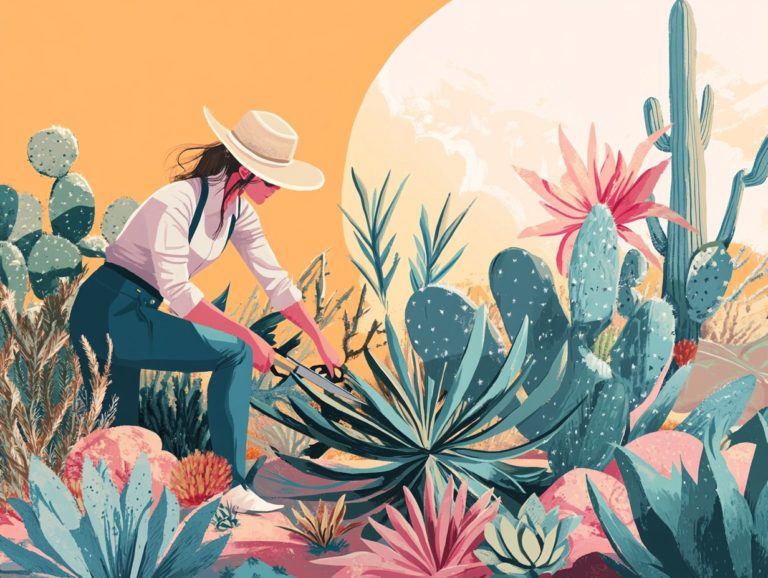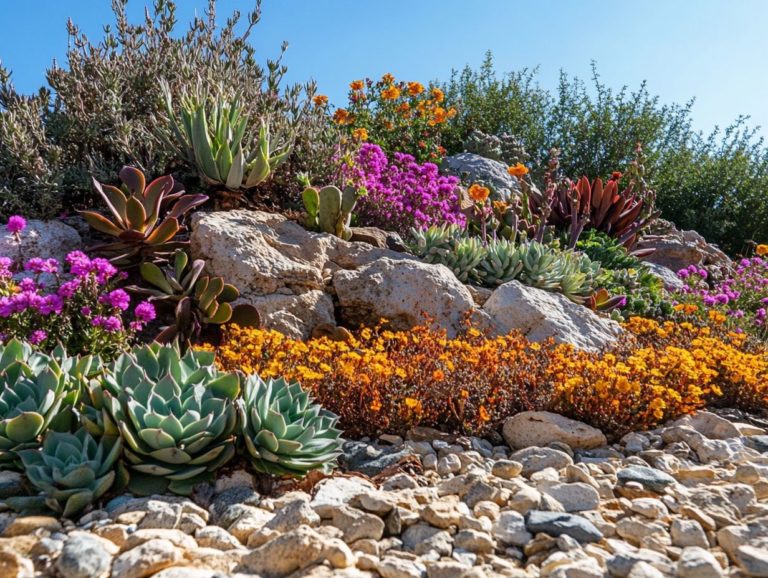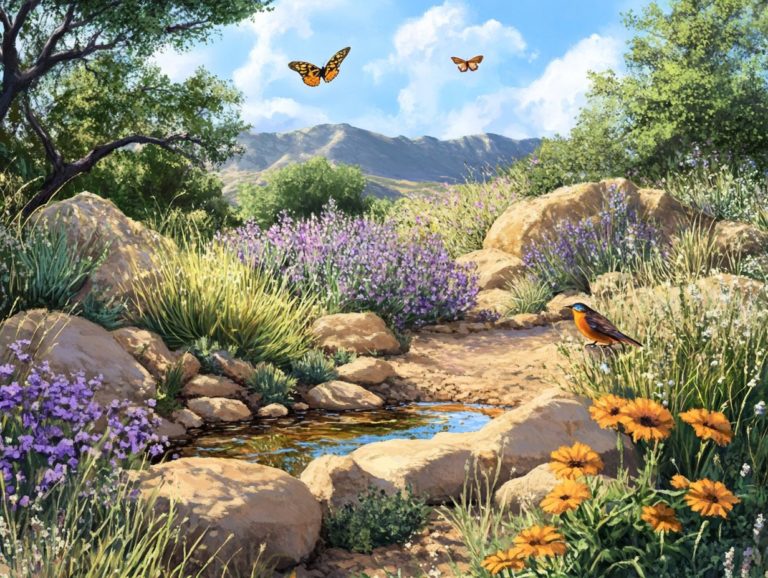Are There Drought-Resistant Trees for Urban Areas?
Urban areas are grappling with escalating challenges posed by climate change. Drought resilience is now more essential than ever for you and your community, especially through tree-planting campaigns.
Selecting the right trees can dramatically elevate city landscapes while promoting environmental sustainability.
This article delves into the significance of drought-resistant trees. We’ll showcase their myriad benefits for urban settings, their role in climate mitigation, and the key traits that make them ideal. We’ll also highlight the top tree species you should consider.
You’ll find practical tips for planting and nurturing these trees, along with additional strategies to help fortify urban environments against drought. Explore how these green giants can flourish even in the face of adversity!
Contents
- Key Takeaways:
- Why Drought-Resistant Trees Matter in Our Cities!
- Characteristics of Drought-Resistant Trees
- Best Drought-Resistant Trees for Urban Areas
- Planting and Caring for Drought-Resistant Trees
- Other Strategies for Drought-Proofing Urban Landscapes
- Frequently Asked Questions
- What are drought-resistant trees?
- Why are drought-resistant trees important for urban areas?
- What are some examples of drought-resistant trees for urban areas?
- Are there any benefits to planting drought-resistant trees in urban areas?
- What factors should be considered when selecting drought-resistant trees for urban areas?
- Can drought-resistant trees be used for landscaping in urban areas?
Key Takeaways:
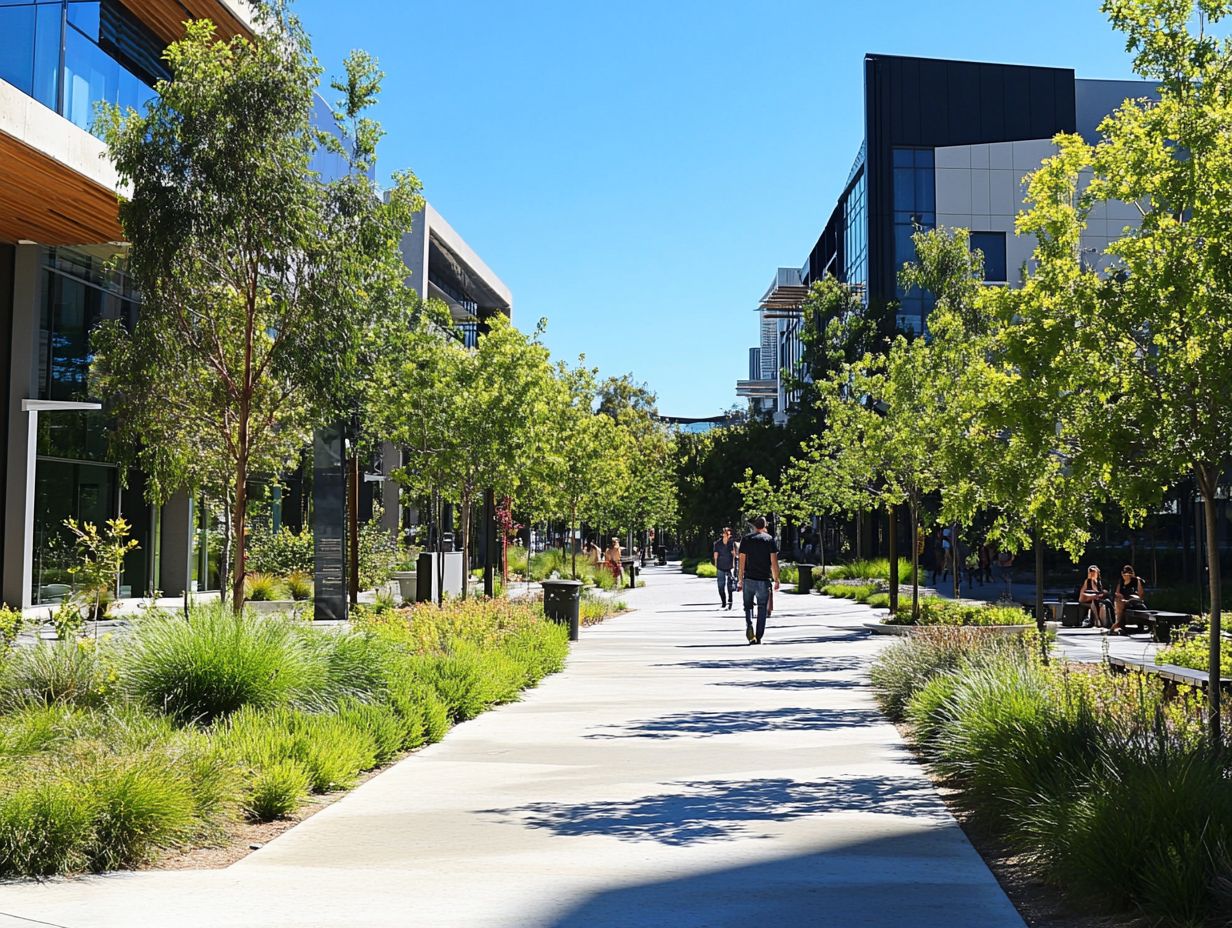
- Drought-resistant trees provide shade and improve urban air quality.
- Look for trees with deep roots and small leaves to withstand drought.
- Some of the best drought-resistant tree species for urban areas include native trees like red maple and white oak, as well as non-native species like Chinese pistache and Eastern red cedar.
Why Drought-Resistant Trees Matter in Our Cities!
Drought-resistant trees are vital in urban environments. They help address the challenges of climate change and improve air quality, making it important to know what the best drought-resistant plants are.
As cities such as Los Angeles, Miami, and Baltimore face increasing droughts and water scarcity, choosing climate-adaptable tree species becomes essential. The U.S. Forest Service emphasizes the need to incorporate these trees into urban landscapes, fostering sustainable ecological habitats that nurture native biodiversity and enrich the urban canopy.
Benefits for Urban Environments
Drought-resistant trees offer a wealth of benefits for urban environments. They enhance air quality, increase tree cover, and foster the development of green spaces that encourage community forestry initiatives.
These amazing trees are essential for cleaning our air by filtering pollutants and releasing oxygen, which is especially vital in densely populated areas. For instance, cities like Los Angeles and New York have recognized the importance of such initiatives in reducing heat-related fatalities during extreme weather events.
Native trees play a key role in these efforts. They serve as cornerstones for maintaining ecological balance and supporting urban biodiversity by providing habitats for various species. By integrating these resilient tree species, you not only beautify the urban landscape but also actively engage your community in sustainable practices, ultimately contributing to healthier living environments.
Characteristics of Drought-Resistant Trees
Drought-resistant trees boast distinct characteristics that empower them to thrive in challenging urban environments. These features, including drought tolerance and adaptability to diverse soil conditions, enable species like the Kentucky coffee tree and black tupelo to thrive even amidst the growing frequency of droughts.
Choosing the right tree species is vital for mitigating ecological impacts while simultaneously enhancing urban canopy cover.
Join your community in planting these resilient trees today! Together, we can create a greener, healthier city!
Drought Tolerance and Adaptability
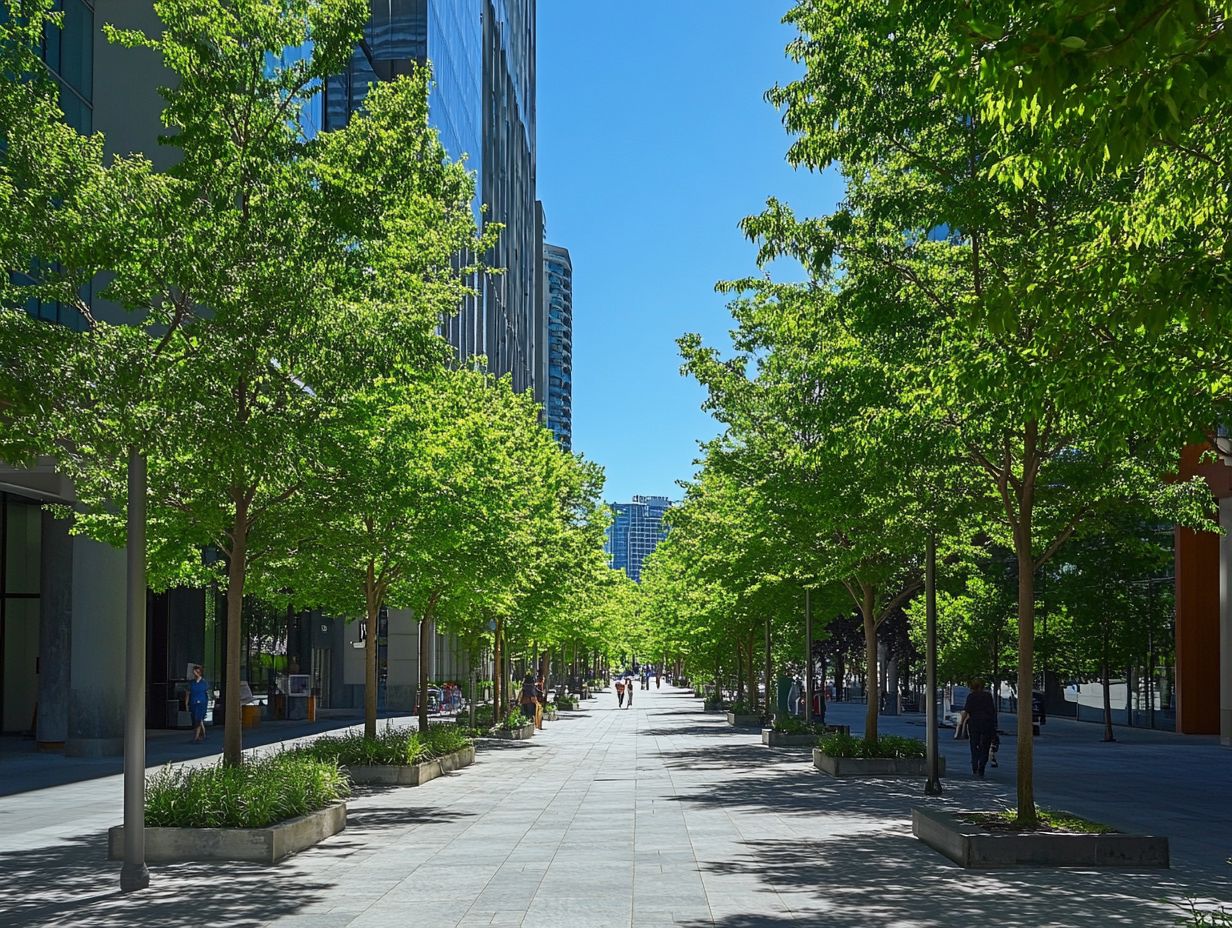
Drought tolerance and adaptability are key traits for trees to thrive in urban environments, where water can be scarce and soil conditions may vary drastically.
Understanding these traits reveals crucial concepts. For example, the turgor loss point is the point where a tree begins to struggle due to lack of water. Different tree species respond in their own ways to the challenges of urban life.
Native species like the oak flourish with their deep root systems, tapping into buried moisture. Meanwhile, non-native varieties such as the London plane tree have adaptations to endure pollution and changing soil conditions.
Both types provide invaluable shade and ecological benefits, showing that trees adapted to local climates can not only survive but thrive in metropolitan settings, enhancing resilience and biodiversity.
Best Drought-Resistant Trees for Urban Areas
Choosing the right drought-resistant trees is vital for thriving urban landscapes! Species like the willow oak, London plane tree, and Tilia tomentosa stand out for their resilience and adaptability to urban conditions.
These trees beautify the environment and boost biodiversity. They also contribute to climate mitigation efforts, making them excellent choices for urban forestry projects.
Top Tree Species for Urban Environments
Among the top tree species you should consider for urban environments are the Kentucky coffee tree, black tupelo, willow oak, and London plane tree. Each of these diverse trees brings unique benefits and resilience to city living, making careful species selection crucial for urban landscapes.
These species adapt remarkably well to the diverse conditions of urban landscapes. They play a crucial role in enhancing the overall urban canopy. For instance, the Kentucky coffee tree has a stunning, open-canopied structure that offers generous shade, while its deep root system helps prevent soil erosion.
The black tupelo thrives in wet conditions and serves as a vital nectar source for pollinators, supporting a rich tapestry of wildlife. The willow oak boasts a magnificent crown that produces ample shade perfect for crowded city spaces.
And let s not forget the London plane tree, renowned for its impressive tolerance to air pollution. This makes it a beloved choice in city parks and streetscapes.
Together, these trees contribute to the ecological balance and biodiversity that urban areas so desperately need.
Planting and Caring for Drought-Resistant Trees
Planting and caring for drought-resistant trees is crucial for their successful establishment and long-term vitality in urban settings. Urban arborists play a key role in guiding tree care practices.
You ll need to follow specific planting guidelines and commit to ongoing maintenance. This is vital for fostering community engagement in urban forestry.
Urban arborists guide you in selecting suitable planting sites and educating communities about tree care practices. Engaging in community forestry initiatives enhances public involvement and fosters a sense of stewardship for urban green spaces.
Ready to transform your urban landscape?
Join us in exploring the world of drought-resistant trees and participate in local urban forestry initiatives!
Tips for Successful Growth and Maintenance
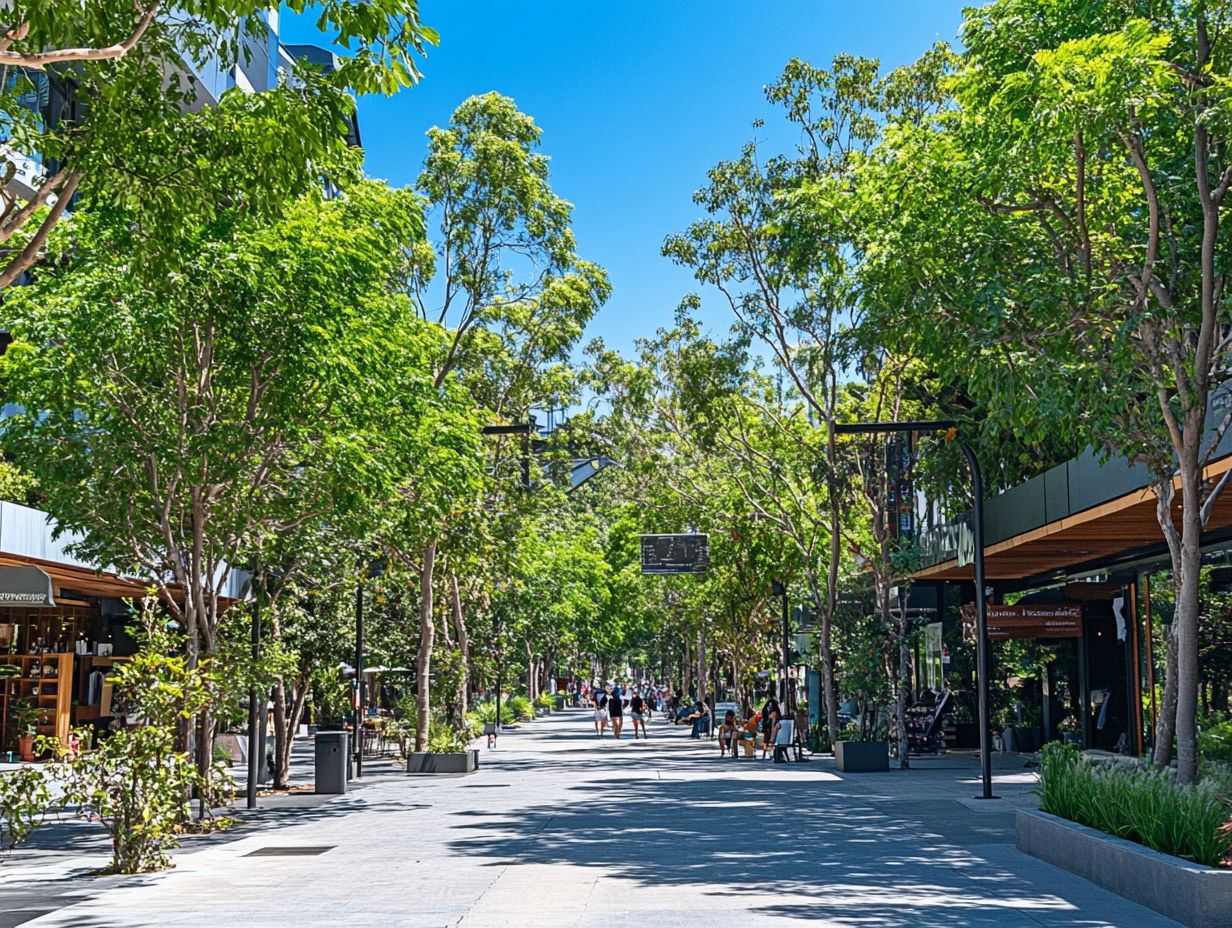
To cultivate and sustain drought-tolerant trees in urban settings, you must adhere to best practices in tree care, particularly focusing on effective watering techniques and soil management.
By adopting efficient watering strategies like deep watering and applying mulch to retain moisture you can significantly enhance tree health. It’s equally important to pay attention to soil conditions; well-drained sandy loams or clay provide trees with easy access to nutrients while reducing water loss.
Don t overlook the potential threats posed by urban pests that may jeopardize these resilient species. Regular monitoring, combined with organic pest management solutions, can safeguard your trees against infestations while preserving the ecological balance of the urban landscape.
By optimizing these elements, you create a sustainable environment that fosters the flourishing of drought-resistant trees.
Other Strategies for Drought-Proofing Urban Landscapes
Besides planting drought-resistant trees, you can explore other effective strategies for drought-proofing urban landscapes, such as innovative water conservation measures and fostering community engagement through educational platforms.
These approaches bolster urban resilience against climate change and encourage sustainable practices within your community, ensuring the longevity and vibrancy of urban green spaces.
Additional Methods for Water Conservation
It’s vital to implement new methods for water conservation to maintain sustainable urban landscapes, enhancing both ecological habitats and community resilience.
To nurture a healthier relationship between urban development and nature, you can adopt various techniques like mulching to retain soil moisture. This not only benefits your plants but also minimizes water runoff.
Invest in efficient irrigation systems to water wisely and cut waste! Engaging in community water-saving campaigns can further amplify these efforts, fostering a collective mindset focused on conscious water use.
By integrating these practices, you can contribute to cultivating urban ecosystems that thrive in harmony, providing vital habitats for wildlife while ensuring the well-being of all inhabitants and fostering cultural ties with First Nations communities.
Frequently Asked Questions
What are drought-resistant trees?

Drought-resistant trees are species that have adapted to dry conditions, making them ideal for areas with limited water.
Why are drought-resistant trees important for urban areas?
Drought-resistant trees play a crucial role in maintaining a green and healthy urban environment. They require less water, can withstand the challenges of urban life, such as pollution and compacted soil, and can thrive in urban settings, contributing to urban forests that enhance air quality.
What are some examples of drought-resistant trees for urban areas?
Some common drought-resistant trees for urban areas include crape myrtle, red maple, honeylocust, Kentucky coffee tree, black tupelo, willow oak, and Chinese pistache. These trees have a high drought tolerance and can thrive in tougher urban conditions.
Are there any benefits to planting drought-resistant trees in urban areas?
Yes, there are numerous benefits to planting drought-resistant trees in urban areas. They can help improve urban landscapes, create green spaces that support native biodiversity, enhance air quality, provide shade, reduce the urban heat island effect, and increase biodiversity in cities.
Join the movement today and make your urban space greener and more resilient!
What factors should be considered when selecting drought-resistant trees for urban areas?
When selecting drought-resistant trees for urban areas, consider soil conditions and climate adaptability.
Choose native or adapted species that thrive in the local environment.
Can drought-resistant trees be used for landscaping in urban areas?
Yes! Drought-resistant trees are perfect for transforming urban landscapes. If you’re wondering where to buy drought-resistant plants locally, they help combat tree loss while maintaining tree cover.
These trees not only add beauty but also require less water and maintenance. This makes them a practical and sustainable choice for urban landscaping.

